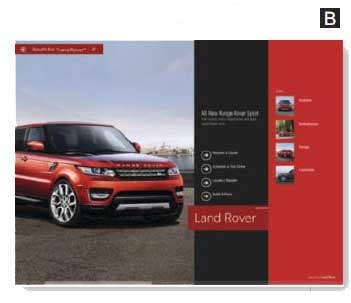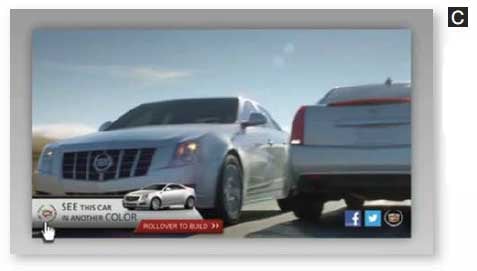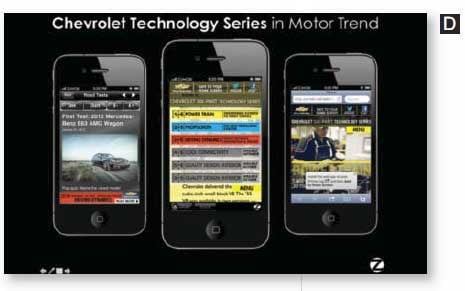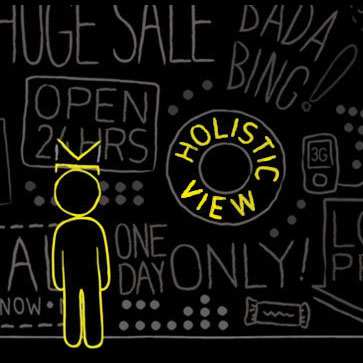Forward-Thinking Ads

via Website Magazine's
Bing, for example, recently started testing a display-style ad unit in the search engine result pages (SERPs), dubbed Hero Ads (see image B). These ads currently only appear to consumers on Windows 8.1 who are using Bing Smart Search for certain brand-specific queries. The unit itself displays calls-to-action for targeted, popular search terms, helping move consumers through the sales cycle. For instance, in the Land Rover example, searchers are encouraged to either request a quote, schedule a test drive, locate a retailer or build and price a vehicle. The goal of the format, according to Bing, is to help consumers quickly find the most relevant information and complete the most common tasks for the brand they are searching for, while providing both a visual and interactive experience.

Aside from Bing's new ad format, the IAB is testing five new rather progressive units as part of its Rising Stars initiative. The new ads are video-centric, and therefore likely to drive deeper engagement than their static or animated predecessors. Wherever greater interaction can be obtained, advertisers will follow - and they already have. In fact, video display ads reached $1.3 billion in revenue during the first half of 2013.
The Rising Star "Full Screen" video unit, for instance, invites viewers to engage and then presents a canvas full of interaction possibilities. In Cadillac's ad that leverages this format (see Image C), the luxury car company prompts viewers to click a call-to-action to customize the color of the vehicle from its video. The video makes the ad interactive, while the added content also brings a strong personalization element to the campaign.

The Digital Video Rising Star concepts were released in February, and since then, have been leveraged by 21 of the top 25 brand advertisers in the U.S., including AT&T, McDonald's and Target.
"The Digital Video Rising Stars deliver the holy grail of sight, sound and motion within interactivity," said Randall Rothenberg, president and CEO, IAB. "The fact that major brand advertisers are already on board speaks volumes about the potential of these ad formats to thrust digital video forward."
Emerging Channels
Shaking up the advertising industry over the last few years is the emerging channel of mobile, which has brought new opportunities for brands to reach their desired audience. In fact, the IAB reports mobile ad revenues hit $3 billion in the first half of 2013. The companies that intertwine this rapidly growing channel into their advertising campaigns are the ones that are sure to outshine (and outperform) the competition.
That said, launching an engaging ad on mobile takes a lot of work, as "banner blindness" is even more prevalent when it comes to mobile. Luckily, innovative companies like Zumobi are leading the way when it comes to mobile advertising, successfully launching interactive ad campaigns that turn up exceptional results.
"It's a real time of renaissance I think for mobile advertising because of banner fatigue and also because brands are really prioritizing the mobile audience because they recognize that it's a really great engagement channel," said John SanGiovanni, cofounder and VP of product design at Zumobi. "So from our perspective it has been an incredibly exciting year in mobile."
Among the top performing mobile ad formats is Zumobi's Paso Doble unit (wsm.co/pasodoblemobile). The company says the format is an alternative to pre-roll and believes that it will enable publishers to integrate video ads like movie clips and commercials into their mobile applications. The unit presents an auto-expandable 320x180 ad that automatically plays to consumers visiting apps on their smartphones. Once expanded, consumers can tap on the video to activate a full screen video and audio experience, or be directed to an external destination. If not clicked on, the ad collapses to a default 320x50 banner state. In September, Zumobi was recognized as a Gold winner of the IAB's 9th Annual MIXX Awards for its part in powering the Chevrolet Technology Series campaign, which leveraged the Paso Doble unit (see Image D). The campaign yielded a 37 percent engagement rate as well as a clickthrough rate of 11.2 percent.

Mobile, however, isn't the only emerging channel making a splash in the advertising industry, as a report from BIA/Kelsey forecasts social media advertising will reach $11 billion in the United States by 2017. Most brands are aware of the large audience and targeting tools that social networks offer, but many have been hesitant to experiment with social ads outside of Facebook. Though that is sure to change as new advertising opportunities arrive on networks like Twitter, Pinterest and Instagram Learn more about the current state of social ads at wsm.co/socialads2013.
The Future Looks Engaging
The Web is intertwined with the physical world more than ever, which puts digital advertising in a favorable position as an optimal way to target audiences and nurture prospects through the purchase cycle. To be successful, however, brands need to move past tradition, and opt for engaging and interactive campaigns.









